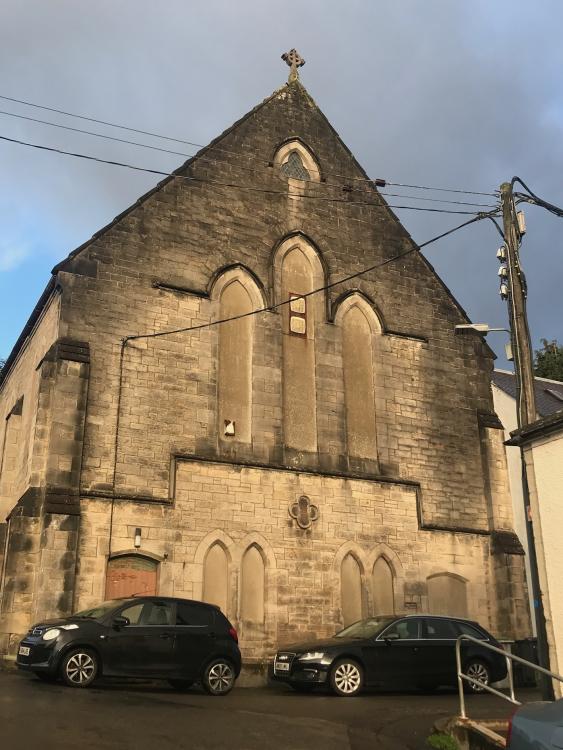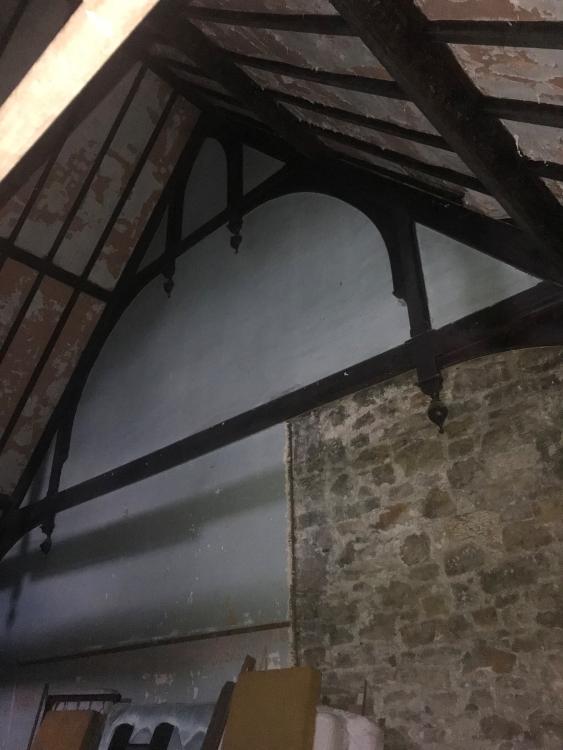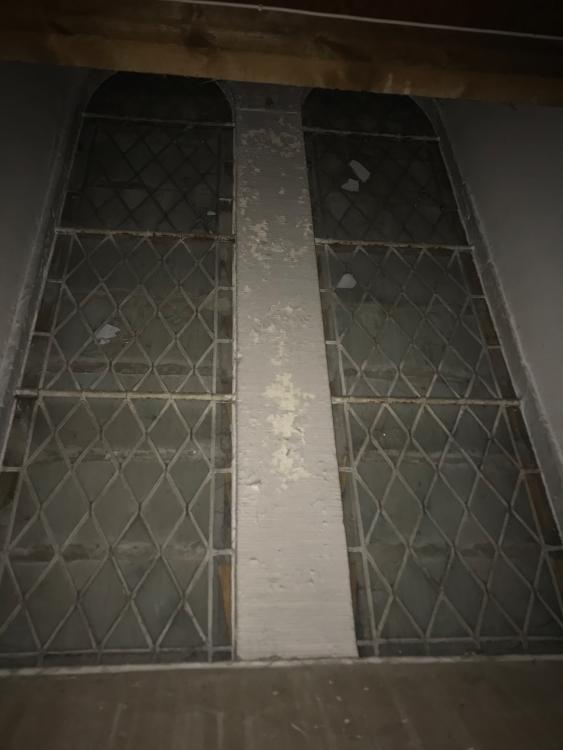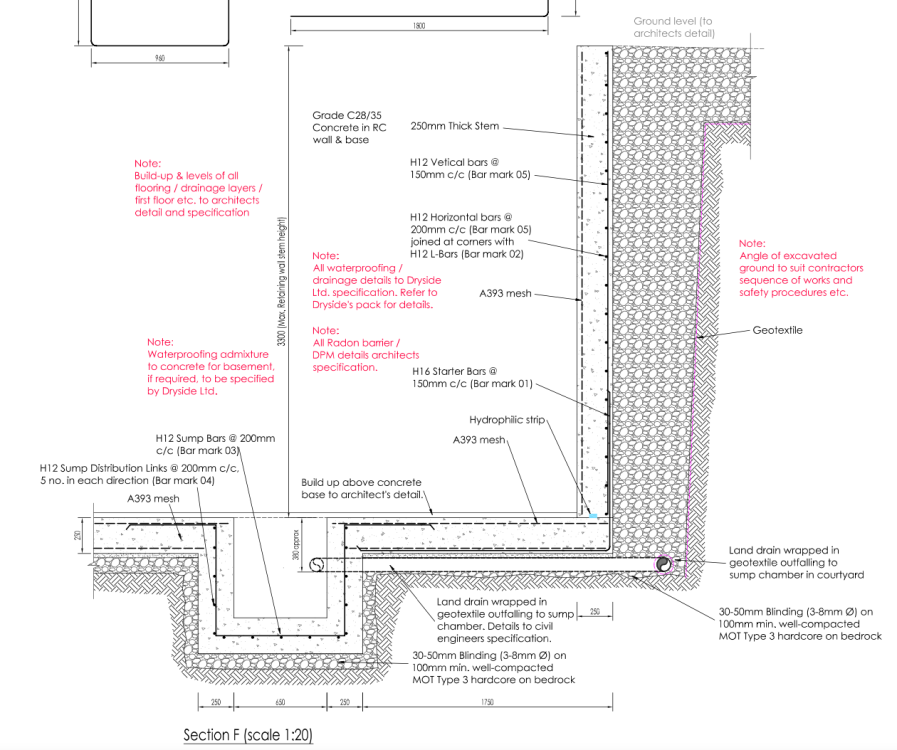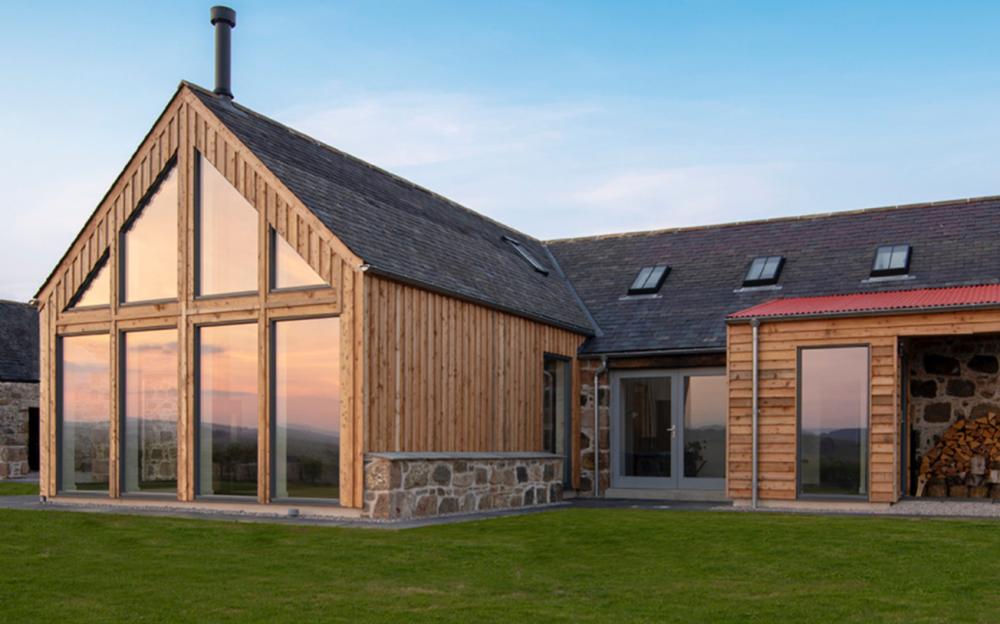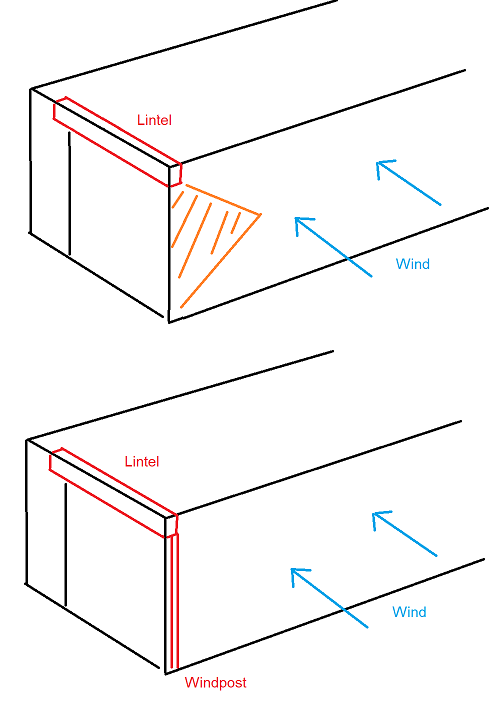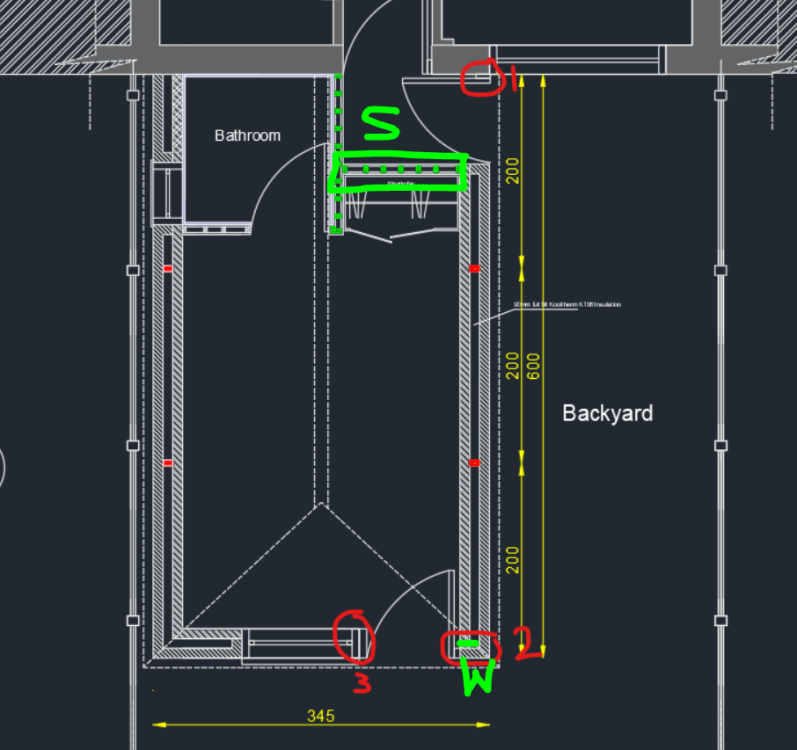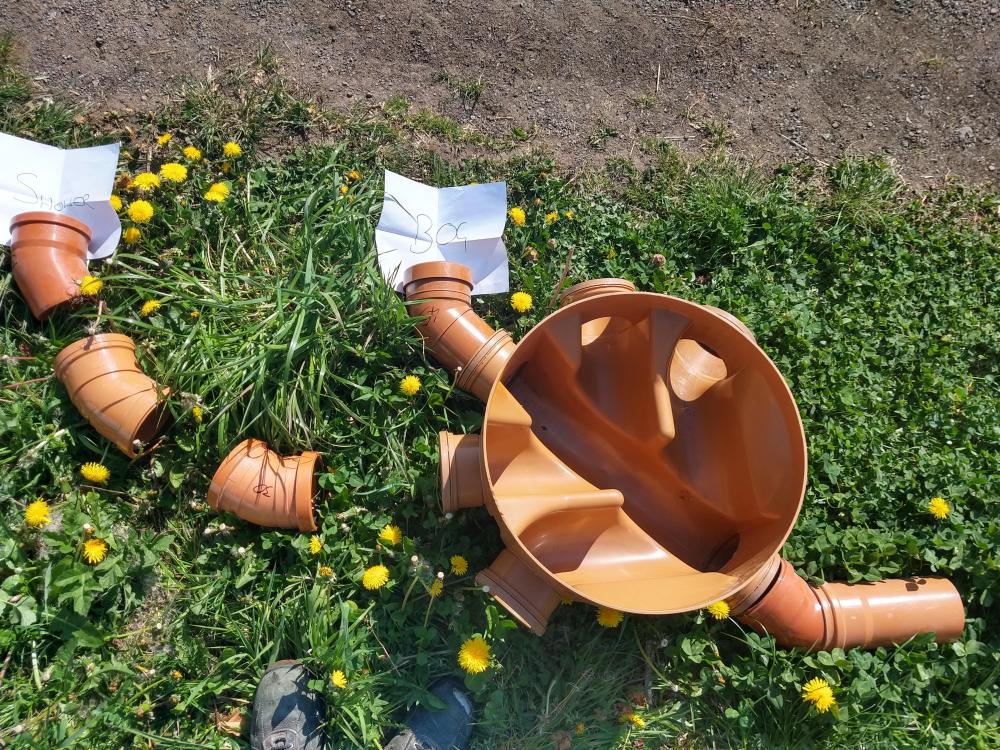Leaderboard
Popular Content
Showing content with the highest reputation on 01/03/23 in all areas
-
Hi all - just purchased old chapel (1870). Currently a warehouse, previous owner got planning approved to convert in 2015, but just to up the valuation, no work ever undertaken, & left the place unmaintained since then so it's in a fairly derelict state. 2ft-thick walls of solid stone with Scottish slate roof, lathe & plaster under. Skews failing so the East-facing gable ends are leaking & a hole has developed, so first job is to get these areas covered up/new guttering etc & dry the place out. Other than that the fabric is pretty solid, though they did also fill in beside the building with deep concrete to enable easier loading/unloading, so that will all have to come out also as front left basement/undercroft is soaking. They also whacked in an additional floor for the warehouse (original church floor being sloped) using steel girders. Pretty large for a first project, so will have plenty of questions on every aspect - I discovered this great resource before proceeding, so I felt a little more secure in being able to get first-hand insights with no axes to grind wrt recommendations & alternative approaches. Using a heritage specialist surveyor recommended by Scottish Lime Centre, so looking to steer course between modern efficiency & best/sympathetic materials. Planning to add an additional floor, with wet underfloor heating, though each floor will require a different approach. Tbh with all costs sky-rocketing, not sure my budget will stretch to completion, but will at least get past it's most fundamental problems. Meeting with surveyor & architect shortly so any observations or questions I should ask would be useful - looking forward :+}2 points
-
It becomes a problem when the stone starts to spall, which is too late. Is it sandstone? There is a very informative youtube showing a pair of semis, where one is being ruined by cement mortar and the other remains sound. Found it https://www.youtube.com/watch?v=3Omxc4OK9eE Not urgent but bear it in mind. You have loads of height, so can you retain the floor and build another insulated one on top? About 200mm.2 points
-
I think the key phrase there is, "which we all know". Did you leave instructions as to the type of heating and how it differs from conventional radiators. If not :- I don't think the people were necessarily 'stupid', just not aware. I think the "we all know" is largely limited to members of this type of forum.2 points
-
90% of your tools will be battery powered. Only mains powered items I have are a 9" grinder, 6kg kango and table saw. Safety wise, if you have a prerly earthed and RCBDO supply, then Therese not much in it. Industry goes for 110v on assumption that you won't have these in place2 points
-
Me too, i have spoken to them this morning and i have now have to email them with all the details so hoping to be ok. (fingers crossed) I know! I still can't get my head around I only have one photo unfortunately of the furnished lounge (back from March 2021) but the lovely lady at the council suggested a signed letter from the old owners may also be suffice Will update you if i get something back Once again thanks again for replies2 points
-
Sadly, as this thread shows, there dont appear to be any economically sensible solutions to storing energy for extended periods. Even on a DIY basis, and even if you have unlimited space. I think we have concluded i "can" install a solar array big enough to heat my house all year, but the costs of doing so, again, make no sense, even DIY with second hand kit. The real difficulty, as discussed before, is not knowing what the price of electricity is likely to be going forward. On a supply/demand basis, very much higher than it is now seems "likely". But not with enough confidence to spend a 5 figure sum on the necessary PV installation.2 points
-
yep, permeable clean hardcore all around the basement to allow for free flowing of water. it was basically done to the SE drawings I'm glad I asked for the sump to be made deeper (it's 1500mm now) as the 600mm deep sump would be constantly overflowing if I hadn't and I'd be in real trouble! I've been through my old emails and the Civil engineers did originally design the sump to only take the ACO water from the courtyard. Also, originally the SE specified the land drain to be near the ground level but I asked if it would be better at the basement slab level and they said yes if the water was going to be diverted to the sump and pumped out but they originally specified at ground level so as to utilise gravity. so, tbh, this was all done at my request and I am to blame. but, I am planning on speaking to the SE to ask what ramifications could occur if I block up the 2 x 110mm pipes feeding in to the sump and just let the water gather around the basement. I will also ask if there's a potential solution out of this mess as I would love to not have to worry about the quantity of water entering in to the sump! if I can close it off as you've suggested then I will be one very happy chappy. I'll update on the outcome of those conversations.2 points
-
Sadly I think 50,000J is only 14Wh, not 14kWh. That’s a big old weight you’ll need.2 points
-
Which was the question. The drawings were what sent me back to the question. I hadn't read the previous 5 pages. Helps that I've done a few basements and reservoirs.2 points
-
Gasification boilers themselves are pretty complex - they typically have exhaust extraction fans and oxygen sensors and a control system to ensure accurate gasification. Plumbing a few extra cylinders is a trivial amount of added complexity in comparison to adding a gasification boiler. As for immersion heaters .vs. ASHP, both are possible - I was suggesting immersions as that's probably cheaper (could be done with second-hand cylinders picked up on eBay) and this looks like the only way it might possibly be feasible is if it's done very cheaply indeed.1 point
-
OK, but he also said that fossil fuels may be used as a "fall back" if it cannot be achieved by the end of the decade. This "fall back" period will be impossible to define unless a fully costed program of street by street housing improvements are in place. It's simply not a realistic proposition.1 point
-
Not according to my coffee drinking mate. He bought his Mother a 1500 W panel heater to heat her living room, cost on the meter was just over 6 quid a day. So decided to buy an 800 W oil filled heater, as the oil works like a storage heater, now it only costs 4 quid a day. I did not point out that it was at least 10°C warmer now. He has special physics, but no thermometer.1 point
-
I'd sand/cement screed over the foam glass. NHL5 is used for its strength, not its breathability in this situation.1 point
-
If I've understood their business model correctly, they're unlikely to go bust - all of their capital comes from shareholders, and the business model is essentially to sell the electricity they produce to their customers at close to cost price rather than market price. Unless market prices go below the cost of production (very unlikely for a wind farm!) they're unlikely to go bust. Returns might however be very poor. Plenty of large institutional investors doing exactly the same thing. I get the feeling Ripple was set up because someone wanted to buy shares in a wind turbine and couldn't do it easily, and decided there was a gap in the market to sell these shares. Given the rate of take up, that appears to be true. Energy is very cheap, and most forms of storage have very low energy density. It's a particular problem if you only recharge and use it once a year. Whatever you do a gasification boiler is going to add a lot of complexity. If it's just PV then you can just wire all the immersion heaters up with DPDT relays to replace the SPDT. That way once the first immersion reaches temperature and the relay fires, the current is connected to the next immersion, and so on. Exactly how long would it take for a plumber to get to where you live, 6 weeks? This is supplementing the existing heating system I assume, in which case reliability really isn't that big a deal. Valves, etc. are reliable enough that they're rarely the cause of problems in domestic systems. Problem is to get a decent amount of energy stored you really need a heavy weight a long distance, and there aren't many options for that. Gravitricity seem to be the least hopeless of the lot - using disused mine shafts so the hole is already there - but they don't seem to be able to make it work economically either and are pivoting to hydrogen storage underground. No published data for the big systems, retail price for the smaller ones is in the region of £250/kWh so you'd be looking at £25k or so for a 100kWh system. Capable of storing about £10 worth of heat! 2035 is the current date for fitting no new gas boilers - realistically that means that there will still be gas boilers on the grid in 2050. The transition time is getting up there with the life of a power station, so the capacity really isn't an issue - and I can't find any Labour policies to change this. Electric cars overwhelmingly charge at night when demand is maybe half that during the day anyway. Little or no new capacity needed there. Hard to say when you don't show any calculation! Surface area of the insulation box is ~6m2. To make the maths easier, flatten it out and act as if everything is one-dimensional. To steal from Wiki, In this case, q has units of W/m2 - it's a heat flux not a power. k is 0.035 W/m.K T2-T1 is 500 K L is 0.4m This means q is 43.75 W/m2 and so total losses are 262W (multiply by 6). This means losses are 6.3 kWh/day at full temperature. Sand weighs about 1600 kg/m3 and specific heat capacity is 290 J/kg.K. This means that the heat capacity of 1m3 of sand is 464 kJ/K. 1 kWh is 3600 kJ, so each m3 of sand holds 0.13 kWh/K. This means the temperature in the store would initially drop by 50°C/day - obviously the rate of decay will slow down quickly as the temperature drops, and you really need to solve the integral to plot the behaviour with time (repeating this calculation in excel with time steps is fine). Conclusion: a 1m3 cube of sand is hopelessly small for this application, and 400mm of mineral wool is grossly insufficient as insulation at these temperatures.1 point
-
So close, Dave. I think I'll have to give you that. We have three showers but only use one of them except when visitors are staying. It's been so long that the traps in both of the others had dried out. Took me a day or two to figure it out, but let's just say I ended up following my nose 😉1 point
-
oooh....ooh...I know! you had some correctly sized walk-on glazing and @pocster came and stole it?1 point
-
@Amateur bobso to follow up on @saveasteading’s image / valid point he’s making, this attached image really empathises what they’re really looking for - the planners. This 1st image shows the use of slate & steel roof and local stone in a traditional shaped building. Now this building is clearly an extended original structure but note the low lying stonework. That won’t be structural but effectively a low wall build against the timber frame. Deffo the cheapest and easiest way to incorporate stonework into a rural build even with a finite budget you can build something amazing. If you have several roofs in your design it means you can incorporate both natural slate and steel if they require slate. I’m pretty confident you’ll be able to build something that fits in but is also good quality in terms of materials & architecture. Barn style definitely doesn’t mean boring. the 2nd pic shows a build using just timber cladding and steel so probably built with a tighter budget. To me it lack a bit of material variety, bit too much cladding, and perhaps would benefit from some stonework or even some render. prior to my planning application I sent many of the images I have posted for you to my planning dept, to seek their initial views and they confirmed all would meet design policy requirements. They asked for slate rather than concrete & were 100% right to do so. My application sailed through. Now we know your budget if you were able to post some pics of your plot and any local buildings we can help more. Many of us have done rural Scottish builds and have quite a good collective knowledge & happy to help. Plus we’re free, which helps your budget. also if you have and can use plant equipment in particular a digger that will save you a lot of money for running services. If the services run through your own land you’re on a winner. See my previous posts re that very subject.1 point
-
"Could" easily do so. May not want to. I find 21.5 to be just right in my living room. You also need to factor in the time of year. Peoplec will often want a higher temp in winter than in summer. I found this back when i had a fleet of trains to look after. The complaints were too cold in winter, too hot in summer. The reality was, the temps were always the same. So i made it a twice yearly task to change the target setting. Going from memory, we changed it to 21.5 in winter, 19.5 in summer. Customer complaints largely disappeared. Still the odd, genuine complaint because it was broken of course, but basically solved the issue. Besides, there can be other benfits to more brief attire depending who you are living with.................................1 point
-
The Flir app ecosystem is a bit of a mess so In case you don't know, the Flir Tools app can be used to connect to the camera (not in all cases though) and provide multiple spot temperature readings - which can be positioned retrospectively.1 point
-
1 point
-
As a point of reference, the standard install practice for my Solax hybrid inverter's CT clamp is to extend it (ours was done with CAT6 internally, the manual does not specify) and the install manual says not to go over 100m, so plenty of room to play with. Ours runs ~10m with no issues.1 point
-
We used to run a B&B and that had UFH in the bedrooms, which we all know is slow. We used to keep the thermostats set at 20 degrees. One morning after the guest had left we went to service the room, only to find the thermostat set at 30, the room far too hot, and the window wide open. I guess they wanted it a bit warmer than 20, turned it up, nothing appeared to happen so they turned it up more. Never under estimate how stupid some people are.1 point
-
So many self builders just look at this as "something the big boys have to do", but the onus is absolutely on them. Preventing someones death, ( which includes that of a 5 year old child you've never met or ever even seen before, who has found a loose fence panel to wander through and then falls to their death on YOUR private property ) is on YOUR head, and no other. Some scary shit I kid you not. A lot of the self proclaimed self builders I meet seem to think project management is; go to Screwfix, buy hi-vis and hard-hat, job done order skips make phone calls to find folk to do the work stay up late every night trying to beat the prices they gave them, whilst failing to cost / get the correct stuff, and pissing these people off at the same time when they turn up and cant work that day ask pissed off people to go get the right stuff, which now has cost you 160% of what the original cost would have been. choose colours for pretty things celebrate when you bring the job in; on time, on budget, or not......... @Drellingore Hi, and welcome to the forum. Strap yourself in, as you will get straight talking from folk here who have done this, got the T shirt, and who also got things wrong but were selfless enough to document their journeys ( warts and all ) for folk like yourself to benefit from. I think you are nuts starting this company, and you are very unsure of your actual VAT status. FYI, an accountant is not the best font of knowledge in this respect, so maybe defer to the services of "The VAT man", a paid online consultant who will give you the facts. Others may be available, this is the only one I've heard feedback from. 110v or 230v, matters not a single jot If the 230v supplies are from a certified source with a proven ( tested ) earth protected circuit, then you can use either perfectly acceptably and safely. I always install a 110v transformer and 110v festoon lighting for each of my projects, from start to finish, but zero other 110v items are necessary. 230v will always be required, as trades will need several outlets to plug all their chargers into. Hope this helps.1 point
-
Regarding tools, the only tool on site that is mains powered is a table saw, 99.9% of everything I own is battery powered. Regarding the breaker, just go and hire one for a day.1 point
-
I don't think so. We have about 50‰ extra on capacity. You have to remember that some old thermal plants were ready to be decommissioned, but not actually shut down. Keeping these going a few hours longer makes much more sense than waiting until a new solar farm, or hydro plant is built. As I keep saying, and shall say again. IT DOES NOT HAPPEN OVER NIGHT. While I don't have much faith in any individual government, I do have quite a bit of faith in the National Grid to guide the Civil Service into presenting the right options to the appropriate Ministers. Again, those decisions are not acted on right away, but they do get acted on. This debate about what happens when the wind does not blow and the sun does not shine has been going on for 30 years at least. In that time we have gone from virtually no RE generation to 50‰ generation. And we have had a reliable supply. So your arguement that it can't happen/won't happen is rather wrong. When I was at university studying RE, there was an assumption that more than 30% renewables on the grid would cause massive instability. Well, thanks to behind the scenes investment, decent planning and very clever engineers, along with statisticians, we now frequently have 60%+ RE loading, and still get a reliable supply. And that is before large scale storage has happened. Storage is the next phase in this journey. Storage systems are going to cause more arguements than on shore wind turbines, and a lot more misinformation. You will be told, by someone, that storage uses more energy to make than it will ever deliver. It is up to you to find out if that is true or not, me telling you will not work.1 point
-
So you’re liable for all the CDM elements that a domestic client can pass off - what insurances has the company got in place ..?? Don’t forget that the subs won’t be zero rating as you’re contracting as a VAT registered entity - it’s only the end client that gets the benefit of zero so your cash flow will be VAT inclusive.1 point
-
It’s not going to be continual vibration and tbh you are more likely to get movement from thermal expansion than the stairs being used. Standard Talon clips with spacers will be fine.1 point
-
That raises more questions than it answers. Why does consumption rise? Is it because the insulation is failing? Or because customer use is changing and it would have risen even if no insulation had been fitted? Is the "increase" measured in cost or units of gas consumed? It just seems to be clickbait to push the "you must get a heat pump" message.1 point
-
Only good for a day or so of storage. The unit bench tests well, but add the connective pipework and the losses soon shoot up.1 point
-
Absolutely. It is your and others' interest that made me look at the topic properly, which I had skimmed, being about pump sizes. The original photo showed the extent of the problem. The tech drawings explained better than any words. The variety of expertise on her helps a lot too. Different slants on a subject.1 point
-
"A few heads better than one"1 point
-
When it comes to lossless energy storage you can't do much better than bunch of rocks minding their own business. It takes approx. 50,000 Joules to lift 1000 kg 5 meters (roughly 14kWh) so around 35 tons to see you through the winter.1 point
-
Good for the sole to help out. My thoughts are: That extension is quite long 6.0m and will pick up a bit of wind on the long sides thus you need to stop it moving sideways in the plane of the main rear elevation of the existing house. You starting point here is to ask.. can we transfer all the sideways wind load to the existing building and how do we do that.. and is the existing building able to take the extra sideways loads. It looks like a terraced house. One commonly accepted principle is that if you live in a terrace your house has to take it's "share" of the load. In other words you can't shed load onto your neighbours.. because if everyone starts doing it you can destabalise the whole terrace of houses. The back door introduces a significant break in the load path, that is an anomoly particularly as it is next to a pier which will probably be carrying quite a lot of load from the main roof.. it will protest if you try and use it to hold an extension still. My initilal thoughts looking at the geometry is that you'll need a goal post (steel portal frame) along the front elevation of the extension. If it only extended some 3.5m from the house then you may get away with that masonry return on one side. I would recommend that you speak to an SE.1 point
-
Maximum wall length covered by Part A rules is 12m. Although usually you start to break the rules (due to multiple openings etc) when you go over around 6m. No a lintel won't provide lateral stability. Walls are panel structures and panels need linear supports else they will span in two directions. For masonry this rarely works. A lintel will only support it at a 'point' (in the top corner). The difference looks a bit like this: Orange zone being at risk. I'm afraid we're into the realm of 'step 1: attend university and do a civil engineering degree' but fundamentally, the layout proposed does need a windpost. Best person to speak to next is an engineer who can specify what you need. Potentially a windpost manufacturer would do the calculation for you as well. What I would do is put a windpost at point 'W' and make the studwork wall a shear wall a point 'S' (this would be an extra layer of OSB and some additional strapping to the wall and the floor). Edit - actually what are the red blobs? Are they the proposed windposts or something else?1 point
-
Right, let us say you need 40 kWh (not kwh) a day. Let us also assume you get a heat pump with a CoP of 2.5 (though you would be better off with an A2AHP). So you ned to generate 16 kWh/day. A 1 kWp array, hanging on a south facing wall, will, on average, in December, produce 40 kWh. So 1.3 kWh/day. That implies you need a 12.5 kWp system. Now you need to give yourself a bit of head room, so a 16 kWp system should do it. General rule of thumb about storage is a third of the array size, so 5 to 6 kWh of battery storage. That may be reduced a bit if you can store more thermally, say in a couple of 300 lt cylinders. It is a lot, but not a huge amount. About 80 m2, 16 m by 5 m.1 point
-
Im aware of all that. Indeed, setting it up almost vertical for winter makes perfect sense, which i can do as it wont be roof mounted. However, Id still need a solar farm in mid winter though!1 point
-
Realistically I think your best options are to either buy Ripple shares or put in enough PV that the payment for your summer exports covers your winter energy consumption. Ripple is a lot cheaper.1 point
-
Rather than look at how much energy can be stored, look at how much energy will be lost, and how much insulation is needed to reduce those losses. Also look up Newtons Law of Cooling.1 point
-
Very little pollution when burned efficiently. Actually burning trees in a sustainable way is fine. I don't collect my logs from a petrol station in a plastic netted bag of logs and burn in an irresponsible way. The logs and branches have been grown here and heat my family. No part of this process is wasted. The biochar/compost I have created as a side effect is being enjoyed by all. The sub soil is now full of activity, birds are loving the richness that I have created. It wouldn't really serve a purposes, but smoking outside in the beer garden would be fine.1 point
-
The point is those of us who have trees, you need to do something with the wood. Windfall, normal pruning, and shortly I will be dropping a dead tree. I suppose I could stack it all up to become a mess in my garden for woodlice to live in as it slowly rots and slowly releases it's carbon, or I could give it to someone else to burn. So instead I burn it myself.1 point
-
I reckon those boards are wider than normal scaffold boards.1 point
-
Mine has been approved but like @Mulberry View it was just for surface water drainage not sure about new applications.1 point
-
Something that might change your thinking, if you have solar, is that Octopus will pay 15p/kWh for export on Cosy and only 4.1p/kWh on GO/Intelligent. For me this makes a big difference and means that Cosy would be cheaper than GO/Intelligent even though I have an EV. - I have solar + Heat Pump + EV.1 point
-
At present gas in in the region of 11p per kWh and electricity abut 33p per kWh, so a heat pump achieving a COP of 3 will cost the same to run as a gas boiler. What are the present prices of oil per kWh? @SteamyTea ? (Boilerjuice suggests about 90p per litre so what's that per kWh?) I get the impression some people are "selling" an ASHP as a super cheap means of heating. They are not. Set up properly with a properly designed install they can offer heating to an all electric house at comparable costs to mains gas. They won't improve on the cost of mains gas in many situations. They also give environment benefits as the raw energy use and CO2 emissions are lower.1 point
-
I don't think it looks horrendous but It would be useful if you could separate out your ASHP usage and check your flow temps and weather compensation. That has made a difference to mine. I have noticed that there is big difference in KWh usage for the ASHP when the outside temp gets below freezing. I think my ASHP burned an extra 10KWh on a -5oC day compared to when it was 5oC. The weather compensation ups the flow temp on those days and you do notice it. As a very rough comparison I've divided my total usage into the seasons and averaged the usage per day. Winter is based on the last week when it's been -8oC so I'm hoping it will work out much less than the below. I work from home and we keep it pretty warm in the house. Season Average KWh Per Day Winter 40 Spring 11 Summer 10 Autumn 161 point
-
1 point





